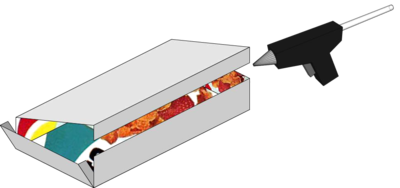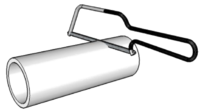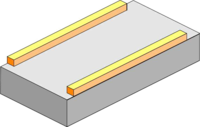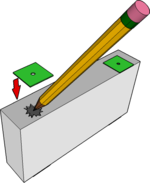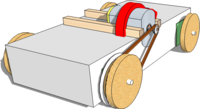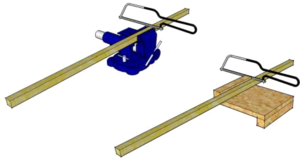Box Modelling: Difference between revisions
From DT Online
m (Added quote) |
mNo edit summary |
||
| (7 intermediate revisions by the same user not shown) | |||
| Line 2: | Line 2: | ||
[[File:GluingCartons.png|400px|right]] | [[File:GluingCartons.png|400px|right]] | ||
__TOC__ | |||
=====Description===== | |||
Used cartons can be taken apart and turned inside out to create a box with a clean, unpainted surface that will accept '''[[Glues and Pastes|PVA Glue]]''' and water-based paint very well. The boxes can be re-sealed using double-sided tape or a '''[[Hot Melt Glues|Glue Gun]]'''. | Used cartons can be taken apart and turned inside out to create a box with a clean, unpainted surface that will accept '''[[Glues and Pastes|PVA Glue]]''' and water-based paint very well. The boxes can be re-sealed using double-sided tape or a '''[[Hot Melt Glues|Glue Gun]]'''. | ||
| Line 8: | Line 13: | ||
<div class="center"><big>''"Make something out of the ordinary, out of the ordinary!"''</big></div> | <div class="center"><big>''"Make something out of the ordinary, out of the ordinary!"''</big></div> | ||
=====Features and Uses===== | |||
---- | ---- | ||
<span style="color: red">'''Safety Point!''' | <span style="color: red">'''Safety Point!''' | ||
| Line 14: | Line 21: | ||
---- | ---- | ||
[[File:CuttingTube.png | | [[File:CuttingTube.png |200px|right]] | ||
Many will be familiar with dried water-based paint soon flaking off if applied to the normal outside surface. This is because the surface is no longer porous and may even be laminated with a thin coating of plastic. | Many will be familiar with dried water-based paint soon flaking off if applied to the normal outside surface. This is because the surface is no longer porous and may even be laminated with a thin coating of plastic. Start by turning the box inside out, as shown above, to solve this problem. | ||
[[File:ReinforcedBox.png |200px|right]] | |||
[[File:PencilHoles.png |150px|right]] | |||
Clean card tubes, from kitchen rolls for example, are another good source of material for '''Box Modelling'''. They also can be glued with '''[[Glues and Pastes|PVA Glue]]''' and painted easily. | Clean card tubes, from kitchen rolls for example, are another good source of material for '''Box Modelling'''. They also can be glued with '''[[Glues and Pastes|PVA Glue]]''' and painted easily. | ||
Boxes can be reinforced, or more detail added, by using '''[[Glues and Pastes|PVA]]''' to glue on strips of clean, bare wood. This is also a porous material and will accept glue or paint well. | Boxes can be reinforced, or more detail added, by using '''[[Glues and Pastes|PVA]]''' to glue on strips of clean, bare wood. This is also a porous material and will accept glue or paint well. | ||
[[File:PoweredBoxModel.png|200px|right]] | |||
Adding such detail can provide mounting points for an '''[[Electric Motor]]''' or could transform a simple box into a model of a half-timbered medieval building for example. | Adding such detail can provide mounting points for an '''[[Electric Motor]]''' or could transform a simple box into a model of a half-timbered medieval building for example. | ||
Holes can be pushed into a card box with a pencil then made into neat bearings for axles by gluing over them a piece of card with a hole made by a '''[[:Category:Punches|Paper Punch]]'''. | |||
| Line 31: | Line 43: | ||
<span style="color: red">'''Safety Point!'''</span> | <span style="color: red">'''Safety Point!'''</span> | ||
[[File:HackSawingWood.png|300px|right]]<span style="color: red">'''[[Hacksaw|Junior Hacksaws]]''' are safe for even quite young children, provided the work is firmly held and a metal cutting blade is used - their teeth are too small to cause real harm, they require least effort to push through the material and do not jam against edges of timber for example.</span> | [[File:HackSawingWood.png|300px|right]]<span style="color: red">'''[[Hacksaw|Junior Hacksaws]]''' are safe for even quite young children, provided the work is firmly held and a metal cutting blade is used - their teeth are too small to cause real harm, they require least effort to push through the material and do not jam against edges of timber for example.</span> | ||
| Line 40: | Line 50: | ||
</span> | </span> | ||
---- | ---- | ||
{{Box Modelling Buyers Guide}} | |||
[[Category:Primary Technology]] | |||
[[Category:Graphics and Modelling Techniques]] | [[Category:Graphics and Modelling Techniques]] | ||
[[Category:Stripwood Technology]] | |||
[[Category:Skills and Processes]] | |||
Latest revision as of 09:18, 24 October 2017
Modelling with 'found objects' is familiar to all young children and might also be called 'junk modelling'. But this not a term used within this web site because even models made with 'found objects' can be quality items - not 'junk' at all!
Description
Used cartons can be taken apart and turned inside out to create a box with a clean, unpainted surface that will accept PVA Glue and water-based paint very well. The boxes can be re-sealed using double-sided tape or a Glue Gun.
Features and Uses
Safety Point! Glue Guns, even so-called low melt ones, squeeze out very hot plastic glue which can cause severe burns. Use only with great care and with adult supervision.
Many will be familiar with dried water-based paint soon flaking off if applied to the normal outside surface. This is because the surface is no longer porous and may even be laminated with a thin coating of plastic. Start by turning the box inside out, as shown above, to solve this problem.
Clean card tubes, from kitchen rolls for example, are another good source of material for Box Modelling. They also can be glued with PVA Glue and painted easily.
Boxes can be reinforced, or more detail added, by using PVA to glue on strips of clean, bare wood. This is also a porous material and will accept glue or paint well.
Adding such detail can provide mounting points for an Electric Motor or could transform a simple box into a model of a half-timbered medieval building for example.
Holes can be pushed into a card box with a pencil then made into neat bearings for axles by gluing over them a piece of card with a hole made by a Paper Punch.
Tubes or thin strips of wood can be cut to length using a Junior Hacksaw.
Safety Point!
Junior Hacksaws are safe for even quite young children, provided the work is firmly held and a metal cutting blade is used - their teeth are too small to cause real harm, they require least effort to push through the material and do not jam against edges of timber for example.
Wood strips can be held securely using a small clamp-on metalwork vice. Older children may be able to cope with a junior Bench Hook held against the worktable edge.
Safety Point! Take great care with hot glue guns and all hot-melt glues. The melted glue can stick to the skin and cause severe burns.
